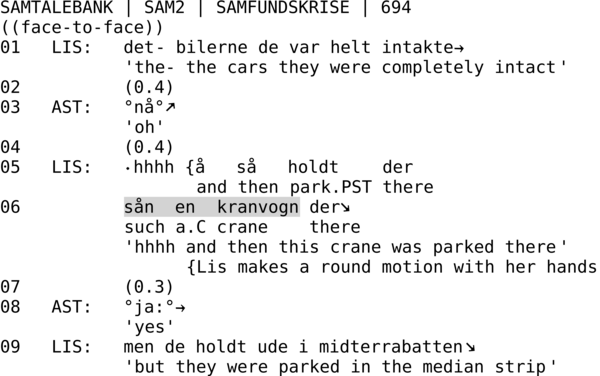Sån en N-construction
Sån en N (‘such an N’, where N is the noun) is a construction which is often seen both in written and spoken Danish, although it is used differently in writing and interaction. In written Danish, sån (‘such’, normally written sådan) is applied prior to a noun as a demonstrative pronoun referring to something in the previous context. In our data, sån en N does not have this anaphoric meaning because sån in this context refers to something outside the conversation.
Sån en N-constructions appeal to assumed common knowledge between the speaker and the receiver by referring to an already established referent outside the conversation which the recipient is expected to recognize. Therefore, the next preferred action after a sån en N-construction will be that the recipient confirms the speaker’s assumption about knowledge of the nominal referent N. This confirmation can be e.g. a ja (‘yes’), mm or a nod.
Three observations from data show that the speaker expects some kind of confirmation after a sån en N-construction; 1) The speaker often pauses after the turn which contains sån en N to give the recipient a chance to confirm, 2) if the recipient does not confirm, the speaker often elaborates his turn with complementary information concerning the referent, and 3) sån en N-turns are often accompanied by epistemic markers such as du ved (‘you know’) and ikk (‘right’), which seek a response from the receiver. In our data, we also see that the speaker can use descriptive gestures while uttering sån en N to further the chances of the recipient giving a confirmation.
The example below shows how sån en N appeals to common knowledge between speaker and receiver and how it gets a confirmation from the receiver:

In line 06, Lis introduces sån en kranvogn der (‘such a crane there’). This item has not been mentioned before in the conversation but obviously seems like a type of thing that the recipient should be aware of what is. It is accompanied by a descriptive gesture. Lis is not finished with her storytelling after line 06 but she makes a short pause in line 07 that gives Asta a chance to show her recognition, and when Asta has confirmed that she recognizes Lis’ reference, Lis continues.
Variations of this pattern is what we find in our data when it comes to sån en N.
Sources and further reading
Asmuß (2011) is a chapter from a scientific book (Stivers, Mondada & Steensig) about the use of du ved (‘you know’).
Jensen, Eva Skafte (2013a) is a scientific article about sådan in spoken language.
Pedersen (2014) is a term paper, published in the Skrifter om Samtalegrammatik (‘Papers on Interaction Grammar’) series. It contains a thorough description of what this entry presents.
Sacks and Schegloff (1979) is a scientific article that deals with how new referents are introduced in conversation.
